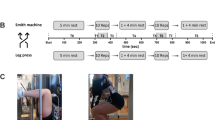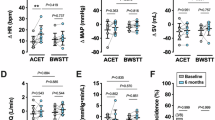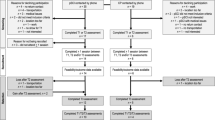Abstract
In able-bodied subjects heart rate and oxygen uptake have a linear relation up to submaximal workloads. Cardiac response to exercise or physical stress is described to be under the control of the sympathetic nervous system. Various workers have claimed that the sympathetic contribution to the cardiac plexus arises between thoracic spinal cord levels T1 and T6. Paraplegics are participating in various sporting activities in increasing numbers. Theoretically, assessing the progress of physical fitness of paraplegics with lesions above T6 by monitoring heart rate alone becomes unreliable because of damage to their sympathetic system.
Forty-four paraplegics with lesion levels between T3 and T10 were put through an arm cranking exercise routine with increasing power levels. Their heart rate and oxygen uptake was measured for each power level. For analytical purposes the subjects were grouped into two groups according to their lesion level. All the subjects with the lesion at T6 or above were in one group and the other group consisted of lesion at T7 or below. Almost linear relation was found between the heart rate and oxygen uptake in all subjects of both groups.
The findings of this study suggest that either the sympathetic contribution comes from above spinal level T3, or the cardiac response to an increased demand in physical exercise is controlled by some other mechanism.
Similar content being viewed by others
Log in or create a free account to read this content
Gain free access to this article, as well as selected content from this journal and more on nature.com
or
References
Astrand P O, Rodhal, K 1977 Textbook of Work Physiology. McGraw Hill, New York.
Butler P, Engelbrecht M, Major R E, Tait J H, Stallard J, Patrick J H 1984 Physiological cost index of walking for normal children and its use as an indicator of physical handicap. Developmental Medicine & Child Neurology 26: 607–612.
Consolazio, et al. 1963 Physiological Measurements of Metabolic Functions in Man. McGraw Hill, New York, p 315.
Coutts K D, Rhodes E C McKenzie D C 1983 Maximal exercise responses of tetraplegics and paraplegics. Journal of Applied Physiology 55: 479–482.
Frankel H L, Mathias C J 1980 Severe hypertension in patients with high spinal cord lesions undergoing electro-ejaculation management with prostaglandin E2. Paraplegia 18: 293–299.
Guttmann L 1976 Spinal Cord Injuries. Comprehensive Management and Research, 2nd edn. Blackwell Scientific, Oxford.
Guttmann L, Whitteridge D 1947 Effects of bladder distension on automatic mechanisms after spinal cord injury. Brain 70: 361–104.
Head H, Riddoch G 1917 The automatic bladder, excessive sweating and some other reflex conditions in gross injuries of the spinal cord. Brain 40: 188–263.
Knutsson E, Lewenhaupt-Olsen E, Thorsen M 1973 Physical work capacity and physical conditioning in paraplegic patients. Paraplegia 11: 205–216.
Leger L, Thivierge M 1988 Heart rate monitors: Validity, stability and functionality. The Physician and Sports Medicine 16: 143–151.
Lindan R, Joiner E A, Freehafer A A, Hazel C 1980 Incidence and clinical features of autonomic dysreflexia in patients with spinal cord injury. Paraplegia 18: 285–292.
MacGregor J 1979 The Objective Measurements of Physical Performance with Long-Term Ambulatory Surveillance Equipment (L.A.P.S.E.). In: Stott FD, Raftery EB, Goulding L (eds) Proceedings of 3rd International Symposium on Ambulator Monitoring. Academic Press, London, pp 29–39.
Oxylog Instruction Manual, P.K. Morgan Ltd.
Silver J R 1971 Vascular reflexes in spinal shock. Paraplegia 8: 231–242.
Tsanakas J N, Bannister O M, Boon A W, Milner R D G 1986 The ‘Sport Tester’: a device for monitoring the free running test. Archives of Disease in Childhood 61: 912–914.
Author information
Authors and Affiliations
Rights and permissions
About this article
Cite this article
Bar-On, Z., Nene, A. Relationship between heart rate and oxygen uptake in thoracic level paraplegics. Spinal Cord 28, 87–95 (1990). https://doi.org/10.1038/sc.1990.11
Issue date:
DOI: https://doi.org/10.1038/sc.1990.11



